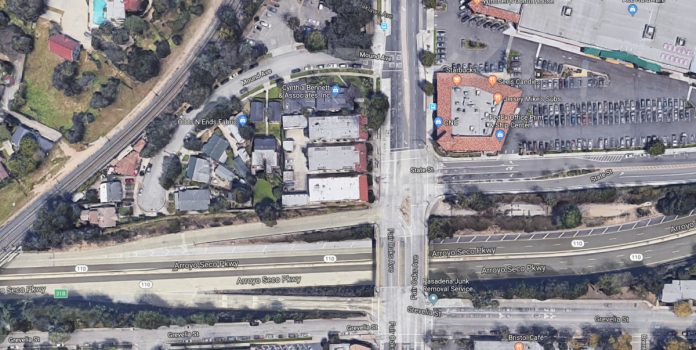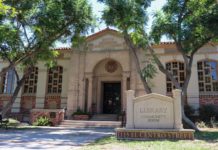
The City of South Pasadena, Metro and Caltrans will study a traffic solution alternative for the SR-110/Fair Oaks Ave. interchange that does not include construction of the long-contemplated “hookramp.” The decision was taken without consultation from the city’s Public Works or Freeway and Transportation Commissions, which have been sidelined pending a restructuring of those bodies.
The hookramp would allow drivers on Fair Oaks to turn east onto State Street and make a U-turn taking them to southbound SR 110. The city will also study alternatives that include the hookramp along with ancillary traffic revisions such as signal synchronization and bulb-out removal.
The revelation came Feb. 19 as the City Council received an update on its five-year Capital Improvement Plan. On a list of 34 projects, the last was the “110 Interchange Project,” for which Metro provided an allocation from funds previously slated for the now-defunct SR-710 extension. It was the only item on the CIP list for which no start or completion dates were given, and the only one that did not have a one-line physical description of the project.
Rather, noted Councilman Michael Cacciotti, the “description” field said only that the city was waiting for Metro to provide a draft of the funding agreement for the interchange. He asked Public Works Director Shahid Abbas to describe the project itself. “We’ve had so many proposals or projects over the years. I’m not sure anyone in this room knows what project you’re talking about,” Cacciotti told Abbas.
“What we’re trying to find out,” Mayor Bob Joe interjected, “is: is there a project or study or something being done for that money? We have no feel. All we have been hearing is the money is coming but we don’t know what the project is.”
With prodding, Abbas explained that staff had reviewed the project as described by Metro—which was based on one of the mobility improvement projects submitted by the city for funding–and found its footprint was too small. “We are going to study the traffic along Fair Oaks Avenue and along Fremont Avenue and all the side corridors that are feeding into Fair Oaks Avenue and figure out what options are available to move traffic safety and efficiently along [the] Metro corridor to relieve the traffic burden,” he said.
As Abbas later elaborated for the South Pasadenan News, the footprint originally went only from Grevelia St. to State St. A “proper study” should include a larger area, principally so that any impact does not simply push congestion further south along Fair Oaks. During “multiple meetings” over the past four months, Metro and Caltrans agreed to a “rescoping” that encompasses a larger study area. He said formal approval of the rescoping will come only as part of the final funding agreement, which he doesn’t expect to see from Metro for another six-to-eight months.
In an email, Metro spokesman Brian Haas said that “since planning, feasibility and similar studies are to be funded by project sponsors, no funding agreements were required at this time. Upon completion of the traffic study and determination of the scope of the project by the City of South Pasadena and concurrence by Caltrans and the City of Pasadena, the appropriate agency agreements will be executed to accommodate funding and advancing the project to environmental and design phases.”
Abbas also told the Council there is a problem securing the right-of-way needed for the hookramp, as it is owned by the City of Pasadena, which he said has asked for more data. Hence the need “to study other options, along with the hookramp.”
The hookramp will remain an option, Abbis affirmed. “There could be a project which will be other elements plus the hookramp, or a project without the hookramp.” He said a comprehensive analysis will be done.
No one knowns what the hookramp will cost. Abbas told the City Council that “about $28 million” had been set aside for the hookramp. He later told the South Pasadenan News he thought the funding was $48 million or $50 million. Actually, Metro “programmed” a total of $70 million for the interchange in two separate decisions: $38 million in December 2018 and $32 million in September 2019. It is unclear what will happen to the money if the hookramp is not built or if not all of it is spent on projects compatible with Metro’s programming.
Abbas said the Council had been kept informed about the no-hookramp option. He said it came up in a brief CIP presentation he made to the Council on Nov. 6. A recording of the Nov. 6 session does not reflect that.
Joanne Nuckols, who served as chair of the city’s expiring Freeway and Transportation Commission (FTC) through the end of 2019, said she was unaware of the deal the city made to rescope the project. The Council late last year suspended meetings of both the FTC and the Public Works Commission pending finalization of a plan the city has long sought to restructure both bodies, a plan to which the Council gave final approval Feb. 19. But new commissioners have yet to be appointed to the restructured commissions, and those on the expiring boards held their final meetings in mid-December.
“They basically dismissed us prematurely,” Nuckols said. “So there was no citizen review or recommendation from the Commission to the City Council” about the rescoping.
A long-time member of the Design Advisory Group chartered by Caltrans on which both Mayor Robert Joe and Councilman Richard Schneider also served, and which initially reviewed the hookramp project along with other alternatives, Nuckols said “it is clear to me now that with the increased traffic on Fair Oaks at the 110 that a non-hookramp or variation thereof is not sufficient to deal with all the congestion on the bridge.”
Kim Hughes, chair of the Public Works Commission through last December, said she too had been unaware of the rescoping. As for the efficacy of the hookramp, she deferred to John Fisher, a retired City of Los Angeles Department of Transportation assistant general manager who has also been serving on the Public Works Commission.
Fisher told the South Pasadenan News he didn’t know what Abbas means by “hookramp.” He said there are at least two concepts that have been floated. The one the city has been looking at for decades would send drivers three-quarters of a mile east of Fair Oaks, adversely impact the Raymond Hill neighborhood and force a relocation of the existing State St. offramp, impinging on the property of Pasadena’s gas-fired Glenarm power plant. The option, he says, is “not feasible.”
Fisher recommends a configuration he presented to the Public Works Commission, which he calls the “Loop.” It would use the right-of-way of the currently fenced-off, existing but abandoned off ramp parallel to and south of State St. It would not require drivers to go as far east before making the U-turn to descend onto the southbound freeway lanes.
Fisher said he is aware there “may have been informal discussions” between Metro or Caltrans and some South Pasadena citizens not affiliated with city government but interested in the disposition of the hookramp.
He said in addition to the $70 million from Metro, former Congressman James Rogan secured another $10 million for the hookramp many years ago and that the government has threatened to withdraw those funds if they are not used soon. He’s been told the money could be used for signal synchronization on Fair Oaks and other streets, which he supports. “They need to build important improvements there that will reduce delays at that intersection. But signal synchronization would not substitute for any ramp improvements.”
Abbas told the South Pasadenan News that neither he nor his staff have ever floated the idea of abandoning the hookramp in favor of a slate of improvements such as synchronization, bulb out removal and other traffic revisions funded with the Rogan money. But the hookramp concept the city has been working with is very old and does not consider the impacts of the demise of the 710 extension. The hookramp “may be viable” with or without other improvements. “We are open to all possibilities.”




















.png)










Although this article appears to be about the hookramp, it is another demonstration of the continued unwillingness of city management to involve the public, the commissions, or even the Council, in its actions. When will the Council wake up and end the autocratic rule that has taken over the city?